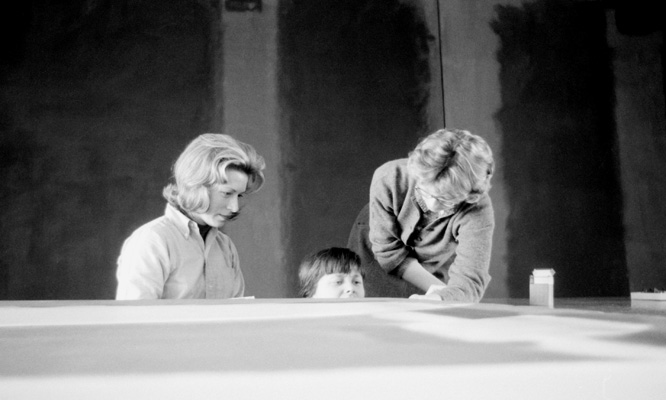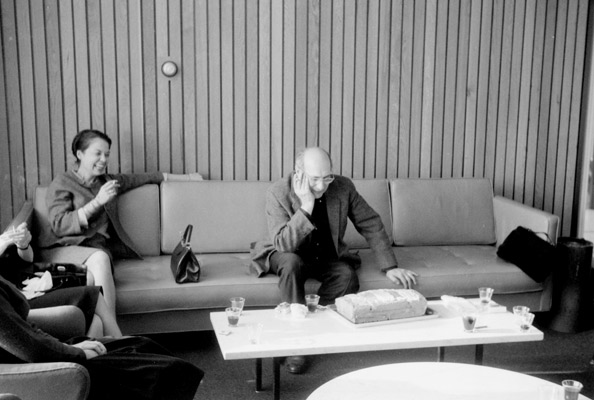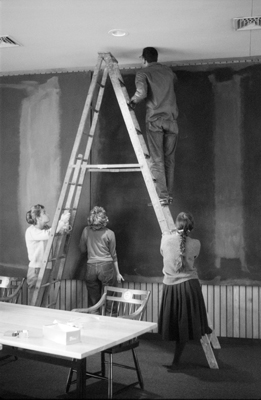The inaugural special exhibition at the Harvard Art Museums this November will propose an exciting new presentation of Mark Rothko’s Harvard Murals, which have not been seen by the public for many years. The American abstract expressionist artist installed the specially commissioned set of five large canvas murals in January 1964 in a dining room on the 10th floor of Harvard’s Holyoke Center (now called the Richard A. and Susan F. Smith Campus Center). However, the high levels of light coming through the dining room’s floor-to-ceiling windows ultimately caused Rothko’s rich colors to fade over time. One of the murals was removed in March 1974, and the remaining murals were removed in April 1979. The five paintings of the commission showed differing patterns of color loss. Deemed unsuitable for exhibition, the murals entered storage and were largely overlooked in the past half-century of Rothko scholarship.
The problem of the murals’ faded colors spurred new scholarship and findings, presented in an exhibition at the Arthur M. Sackler Museum in 1988. It was determined that one factor in the fading was the presence of Lithol Red, an unstable organic pigment the artist used on all five panels. While Harvard conservators now understood why the panels faded so quickly, they continued to seek a means to restore the original hues. The hope was that these important, rare murals might be returned to public view.
In recent years, a team of art historians, conservation scientists, and conservators from two research centers at the Harvard Art Museums—the Straus Center for Conservation and Technical Studies and the Center for the Technical Study of Modern Art—worked with the MIT Media Lab’s Camera Culture research group to come up with a solution: a custom-made software program that controls a digital projector that is used as one of the light sources to compensate for the faded colors on the canvas, pixel by pixel. The original, unfaded colors of the canvases were determined through the use of three sources: faded Ektachrome slides from 1964 that were digitally restored in collaboration with the Imaging and Media Lab (now Digital Humanities Lab) at the University of Basel, Switzerland; a vintage color reference card; and direct color measurements taken from a sixth panel painted by Rothko for the Harvard Murals cycle, which was brought to Cambridge but not installed by the artist in the Holyoke Center.
The exhibition that opens at the museums in November will feature this innovative, noninvasive conservation approach. Light will be projected to “color correct” the paint surface, so that Rothko’s murals will resemble their original state. The exhibition is a proposition; the museums hope it will encourage lively debate and discussion about the introduction of light-based technology as a conservation tool. In addition, the exhibition explores Rothko’s artistic process by presenting more than 30 of his related studies on paper and canvas along with the sixth panel. This will mark the first time that the murals and these studies from the Harvard commission are examined together.
Mark Rothko’s Harvard Murals will be on display November 16, 2014 through July 26, 2015, in the special exhibitions gallery of the new Harvard Art Museums. In conjunction with the museums’ Rothko exhibition, Harvard’s Graduate School of Design will host an installation in the Frances Loeb Library at Gund Hall that addresses the dialogue between art and architecture over the last century, paying particular attention to works and spaces around the Harvard campus.
The research, technical analysis, and conservation treatment on Mark Rothko’s Harvard Murals have been made possible in part through the generous support of the AXA Art Insurance Corporation, the Bowes Family Foundation, InFocus Corporation, the Andrew W. Mellon Foundation, Ezra and Lauren Merkin, Novartis International AG, Lief D. Rosenblatt, and the NBT Charitable Trust. Early exhibition funding has been provided by the Graham Gund Exhibition Fund and the Rosenblatt Fund for Post-War American Art. Modern and contemporary art programs are made possible in part by generous support from the Emily Rauh Pulitzer and Joseph Pulitzer Jr. Fund for Modern and Contemporary Art, Harvard Art Museums. For information about supporting this inaugural special exhibition, please contact Lila Kanner, Associate Director of Institutional Advancement, at lila_kanner@harvard.edu or 617-495-9980.
See the articles in The Boston Globe, Harvard Magazine, Harvard Gazette, and on WBUR’s “The Artery” for more about this exciting exhibition.




